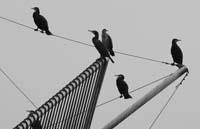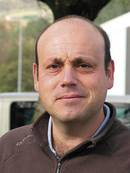Conflicts between wild species and people's interests

"The insult to San Sebastian is to explain what the thread is. He will not know!"
(Azkue'tar Dunixi, 1933: "My People, yesterday")
"Yesterday there was a penguin in the Concha playing with seagulls"
(El Diario Vasco, San Sebastián newspaper, 1987).
It is common that after protecting, preserving and helping a previously broken species, it returns to the previous population or, even without returning, recovers the ancient geographic area. It is enough then that someone considers that the situation is disproportionate and that the species has multiplied enormously, so that the mass-media respect it unanimously and so that with a touch of sensationalism more or less rubbish spreads to the four winds, it is an "invasive species", that generates ecological imbalance and that we are at the gates of many catastrophes. As a result, political leaders of public institutions, always for fear of public opinion, do not waste time to demonstrate that they have ignited the red alarm and are analyzing the measures.
One might think that you might have some sort of control over dangerous species. But in Euskal Herria we have no lion or tiger, and the total population of dangerous beasts present in our territory is: FIRST. Yes, we have only one bear. It does not seem logical, in this situation, to make the decision to destroy more than to protect nature.
There are also species that affect our productive economy and are measures that, surprisingly, have been done with the utmost respect. The owner of a department, or a fish farm, takes care of his business and tries to chase away the animals as far as possible, but can hardly lead a species to extinction. It has no special interest in the species, but in the specimens that affect its business. Producers, conservationists and administrations have collaborated on numerous successful experiences to solve such problems. The exception is insects.
And those who compete, those who consume the same resources we want? Of course, cormorants and otters catch fish; miracles, small birds; and foxes, what they can. Is it lawful to fight them, not because they take away our food, but because they make our entertainment more expensive? We must not forget that these preys that are their pasture are also part of nature, they have no owner. Barbarians also eat mushrooms, snail canyons and clams curves. Mushroom collectors, snails and shellfish don't complain because they understand that nature's essence and nature is the same, and they settle for catching what they can. On the contrary, many hunter-fishermen, through gross and disproportionate arguments, pressure public institutions to act against competing species in charge of everyone's budget. And unfortunately they get the goal too often.
They also tell us that gulls and pigeons and many other species can transmit diseases. It is not a lie, of course, what happens is that they really do not transmit them because many other conditions are not met. In the CAPV there have been no bird cracks or ornithosis in people. Even when we started to restore wetlands, we didn't lack the idea that we would end malaria, but here we are. Simple alarmism is a very big temptation for some.
What about those effects that only bother us if we do not hurt? The gold of pigeons, the noise of seagulls... At this point, it does not seem that the characteristic of an advanced and balanced society begins to die for it.
But what is behind all this? Because there is no doubt that these kinds of issues have taken a different role than we have had before. Apart from the particular interests (that there will always be someone willing to throw the net in whitewater), I would say that there is ignorance of society. An undetermined society does not have its own criteria for taking, believing or rejecting what is called, and depends on others. In this sense, the header mentions are collected. Before, the mere fact of living in a place gave us a direct or erroneous knowledge of their living beings. They were part of personal experience. The Donostiarra knew the alca and the Cegamés the vulture, although later he said that the alca did not fly and that the saí caught the children. But that first essential step was the one that took place; then the following: educate, dress, learn... There were reliable studies, books and sources.
Today what does not appear on TV does not exist. Hopefully, some will read books or Elhuyar magazine. But no one knows that what we have in front of the end exists. Faced with this situation, it will first prioritize the version of what becomes friends with the media and will hardly be modified by those who come later. It would be appreciated, therefore, that public institutions devote themselves solely to information and technical criteria, leaving to the groups of friends the sincere round truths and false signs that are said in the debates of bars, newspapers and gastronomic societies, without automatically becoming their own. Otherwise, we soon turn the Donostiarras alcas back into penguins.






